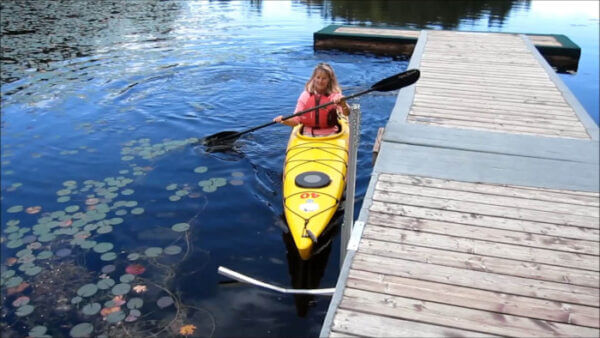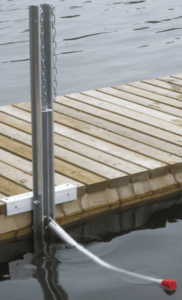For many people, entering and exiting a kayak is a challenge. Traditional entry/exit techniques require balance, coordination, and upper body strength.

Are you looking for easy entry and exit from your dock to your kayak and back again? The patented KayaArm is North America’s solution.
KayaArm makes kayaking more accessible for everyone, from young children to seniors – including beginners as well as those with lower fitness levels or health challenges.
Elderly? Overweight? Artificial joints? Heart or lung issues? Bad knees? How to get into and out of a kayak safely, gracefully, and without getting wet with KayaArm!
The following steps describe how KayaArm can make entry and exit a stress-free experience. For more detail, see the KayaArm instructions page.
8 easy steps for kayak entry and exit
- Use the chain to easily adjust the KayaArm’s height.
- Maneuver your kayak into position.
- Use the KayaArm mast for support as you step into the kayak.
- Place both hands on the kayak’s gunnels and lower yourself into a sitting position.
- Pick up your paddle and push off from the dock.
- When you return to the dock, maneuver your kayak onto the KayaArm.
- Use the gunnels (not the mast) to raise yourself to a standing position.
- Use the mast for support as you step onto the dock.
10 personal situations that make KayaArm essential
KayaArm makes it easier to get into or out of a kayak. For some people, though, KayaArm is essential for a safer and more graceful entry and exit:
- people who have had joint surgery recently or in the past – especially surgeries on the hips, knees, back, and shoulders
- people with bad knees
- people with joint pain or stiffness due to arthritis or other medical conditions
- people having problems with balance or coordination
- seniors with age-related reduced mobility
- people who are overweight
- new kayakers for whom a difficult entry/exit might be discouraging
- occasional passengers looking for a smooth entry/exit experience
- people needing support due to recent injury or illness, or chronic medical conditions
- people interested in injury prevention

